Can planning and monitoring the effects of an SEO campaign be done in-house? It is true that the larger the project, the – as a rule – the greater the need to use the services of an SEO agency. Nevertheless, even if you are not well versed in web analytics, it is possible to do a lot on your own, as long as you understand certain correlations and can see valuable information in dry data.
Here’s a beginner’s guide, which was originally (in a truncated version) included in the ebook “The Art of Data Seduction” from CUX.io.
At the outset, it’s important to adopt a simple rule of thumb:SEO activities make the most sense when you base them on data, rather than “intuition”. Intuition can play a role when, for example, we come up with a topic for the latest article to draw traffic to the site from Google. We know our readers, we know the industry, we know what might be of interest, certain trends we are able to predict or chart. Then the choice of keywords will partly be based on what the voice from inside suggests.
All the rest of the SEO effort is operating on all sorts of data. Then you notice that although SEO is to some extent unpredictable, it is generally governed by fairly logical laws. Many aspects of it can be consciously taken control of. By putting in the right amount of time and energy, you are able to make more money through SEO. Or to put it another way: make your site more visible on Google, thereby driving more visitors to it – and then more money follows.
And while I won’t describe here all the laws and relationships that make up positioning a site on Google, I will show you which data to pay attention to and how to interpret them. This alone will tell you a lot about how to deal with all this SEO. And also, in an ideal scenario, it will inspire further self-study and exploration.
Draw relevant traffic to your site
.
You don’t need traffic on your site – you need converting traffic. This is worth remembering, because too many people focus on increasing their site’s visitor stats without giving much thought to who those visitors actually are. From a business standpoint, only the “right” ones will convert – so, for example, they will sign up for a newsletter, pay for an ebook or subscribe to a service. All the rest will positively affect the statistics in Google Analytics, but not necessarily your bank account.
That’s why you need to build traffic to your site based on the right keyword phrases – because they’re what attract the right visitors. Key phrases and your customer profile are two sides of the same coin. If you know the phrases, you are able to recognize who your customer is. And if you know your customer, you are better able to match key phrases to them.

Let’s focus on the customer for a moment.
Persona, or customer portrait
.
Let’s agree: let’s make the “customer” be the person we care most about in terms of pulling traffic to the site. Maybe he’ll buy right away, or maybe he’ll buy in a year. Or he won’t buy at all – but will comment fondly on our materials, thus urging others to buy. That’s the kind of people we need.
You should have a certain picture in your mind about who is the person who manifests the behavior you want, i.e. visits your site and interacts with it, potentially leaving his money on it.
This image is called a persona. To create a persona, you need to be guided by questions. Here are some examples:
- Demographics: what gender is my client, what age is he or she, how big a city does he or she live in (or does he or she live in the countryside?), what education does he or she have, do they have children?
- Where does he work (in what industry, at what position) and how much does he earn?
- What are his professional goals and ambitions?
- What does he like to do in his free time, what interests him?
- What technologies and information sources does he use?
- What frustrates him and what problems in his life would he like to solve?
- What is his ideal shopping experience?
.
.
.
.
.
.
.
Based on the above information, you can come up with suggestions for keywords that such a prospect would type into Google – these would be both short phrases (e.g., branded phrases, such as “geforce gtx 1050”) and so-calledlong tail phrases (e.g., “best gaming graphics card for $500”).
Are you already beginning to see how persona affects the selection of keywords for which the site is to be optimized, and consequently the entire SEO strategy?
Customer journey – what is the customer journey
.
Then let’s add another element to this, which is the customer journey, or the customer’s buying path. You may be familiar with the concept. In a nutshell: the idea is that a user looking to satisfy a need may be at different stages of the search. Reach back to a time when you yourself wanted to improve the graphics on your computer, start running or choose a gift for someone.
In many cases, you start out knowing little or nothing. That’s why in the first stage you find out. You expand your knowledge. Over time, you shell out some ideas and/or products. You compile pros and cons, compare parameters and prices, read reviews. Finally, you choose a service or product provider. That’s how you became a customer, a subscriber, a regular reader – or all of them at once.
At each of these stages you typed different phrases into Google.
You searched for different information. Those sites that managed to answer your need at a given stage of your search gained you as a visitor. Plus one for the statistics. If you found answers to all your questions on any of them, plus a product at a good price, well, search is over – your consumer need has been met, and the business has made money and perhaps gained a regular customer. Win-win.
Example of a customer journey
.
What might your Google journey have looked like? For example, like this:
“What gift for Father’s Day”. You type, and the pages invite you to read articles with suggestions. It falls on an electric shaver. How about a trimmer? All in all, you don’t know exactly how one differs from the other. So you type in…
“Shaver or trimmer what to choose”. Guides, guides. Reading one of them, you learn that there is such a thing as a full-body shaver for men. To the point. So you type in…
“Body shaver for men”. Now you see pages of products. There are several models that catch your eye. So you type in…
“Shaver XXX test”, and in the tabs next to it “Shaver YYY test” and “Shaver ZZZ test”. You read, you watch, you compare, you make your choice. Dad will be pleased.
If you own a site through which shavers and trimmers can be purchased, you can craft some of the keywords this way. This is part of designing an SEO strategy. There’s no reason to leave it out. But for a strategy to really have arms and legs and be tailored to the type of business you’re doing, you need to back it up with something more.
Common sense thinking and ideas about the prospect and his or her buying path should be supported by data. Intuition can be unreliable, while data provides a greater sense of control and direction. They allow you to accurately identify the current situation – to only build a plan on that. On top of that, using tools that provide datait is possible to accidentally pick up ideas that a person would not have come up with on their own..
Checking key phrases in Senuto
.

A good way to see what your customers are searching for on Google is to use the keyword database in Senuto. Type in “men’s shavers” and in the Queries section you can see what customers are interested in in terms of shavers:
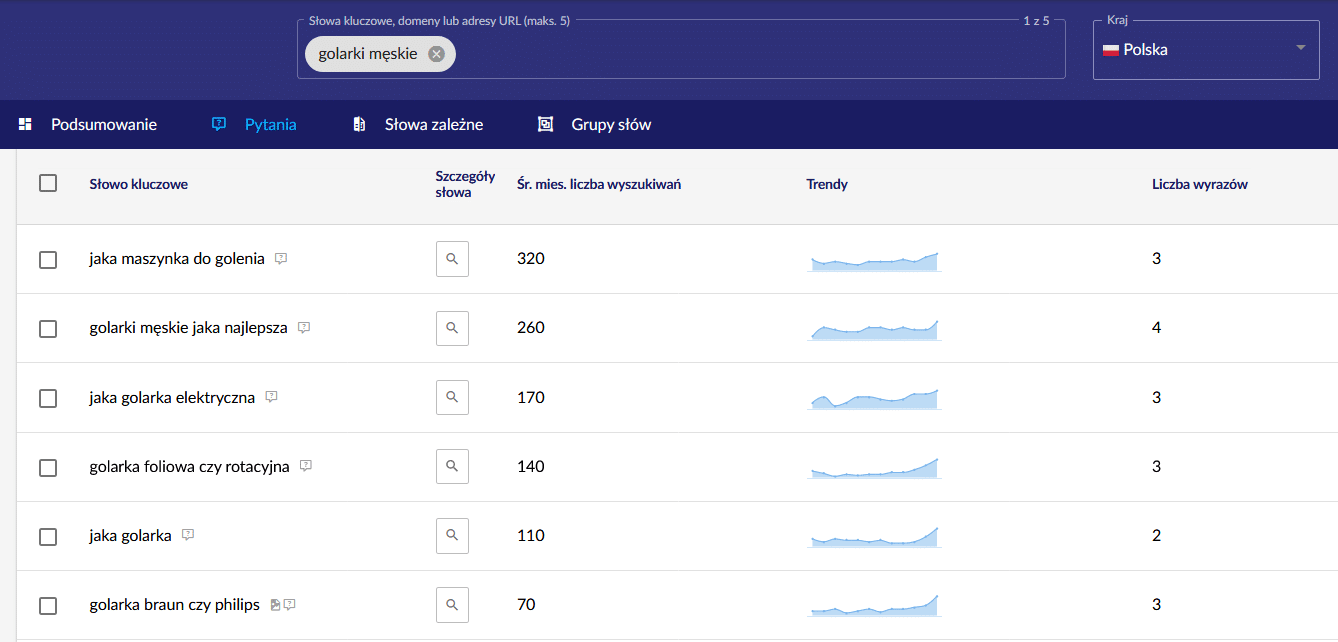 .
.
The average monthly number of searches indicates the popularity of a given query. We can see, for example, that the query “braun or philips shaver” is not particularly often typed into Google. Here, however, an important note:often it is the queries with relatively low monthly search numbers that turn out to be the ones worth covering on your site..
The reason: the more popular the phrase, the – mostly – more competition. And the more general the phrase – for example, “shaver” or “philips shaver” – the greater its popularity.
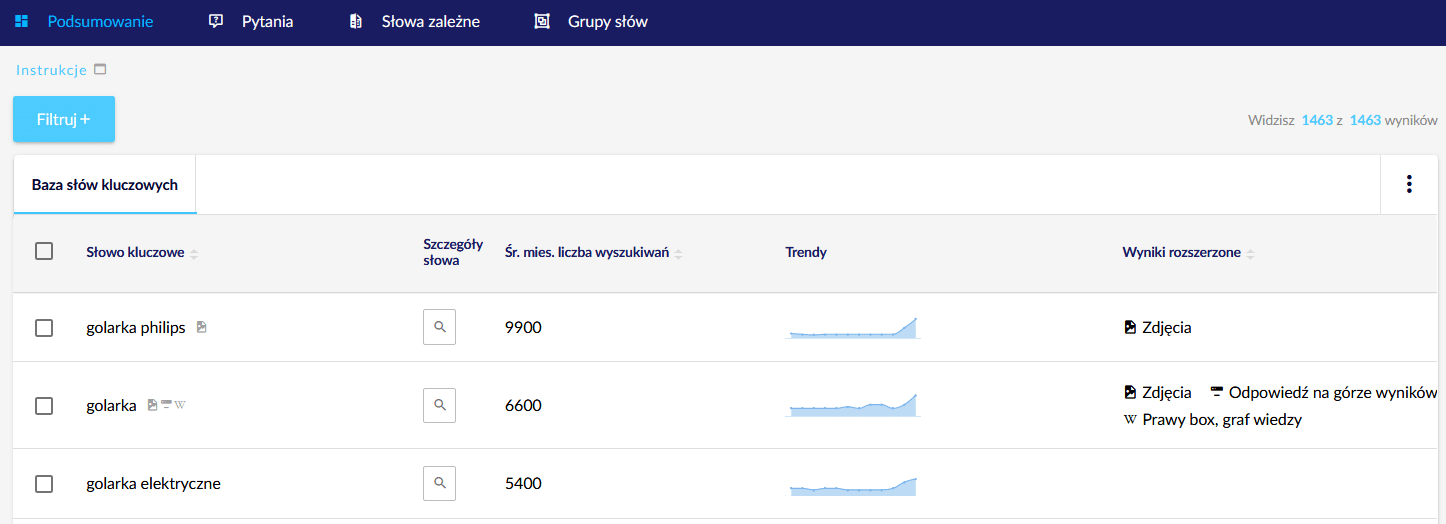
We click on the details of the key phrase “philips shaver”(magnifying glass symbol) and thus see, among other things, SERP analysis, that is, the 20 most visible sites in Google for this phrase.
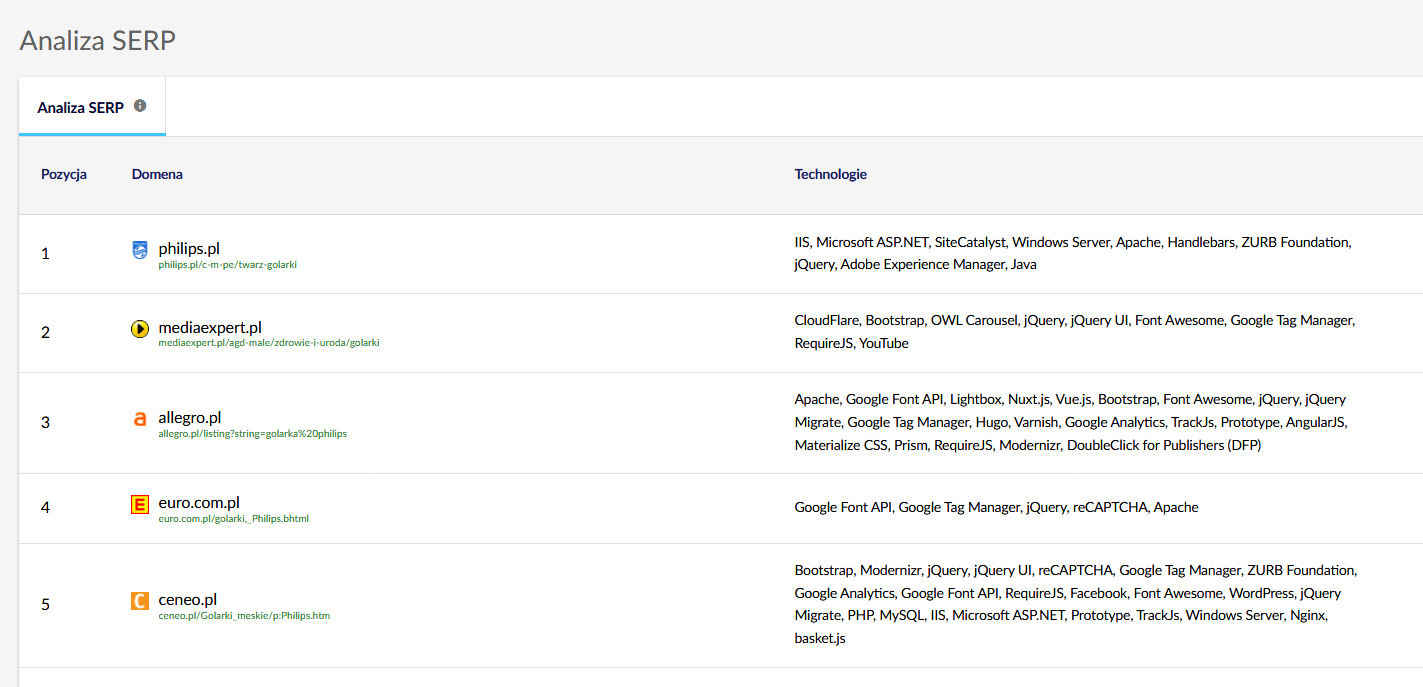 .
.
As you can see, the top positions of search results are manned by really strong players. Are you able to compete with them? Sure you are – if only you have the right amount of time and money. In this case, it would take a lot of both.
The conclusion is that getting into the top positions of Google search results for general and very popular phrases will – for many businesses – be possibleonly theoretically.
In practice, it is better to bet on long-tail phrases, i.e. more specific and less frequently typed questions. The volume of their searches is usually lower, but at the same time the recipient is more aware of what he is looking for. As a rule, it is easier to offer something to such an audience.
This is how, based on the data, you adjust your SEO strategy to your budget and capabilities. You recognize the situation on Google, research competitors and possibly look for niches to develop.
Also check the seasonality of phrases in Google. Some are popular only in specific months. “Garden furniture” might be a hit in July, and “Where to spend New Year’s Eve” might be a hit in December, but not likely the other way around. Thinking in terms of seasonality will be especially useful to you with:
- long-term publication plan for the blog,
- a marketing strategy for your business,
- offering products to your store,
.
.
.

This is how you check which phrases are popular in a given month.
Also use Google Trends to see which months are “dead” and in which you can count on more traffic.
It’s also worth checking the seasonality of your site. A chart in Senuto, based on current keyword positions, determines the sum of the number of searches for all phrases the site is visible for, broken down by month:
 .
.
The topic of site seasonality and key phrases is quite broad, and it’s certainly a good idea to explore it on your own. To quote the words of Milena Fietko, Senior SEO Specialist at Delante: “The most important thing – both for an entrepreneur and SEO agency is not to wake up just before the season and catch yourself with short-term solutions, but to consciously plan and consistently implement actions, the effect of which will be noticeable all year round.”.

How much are Google positions worth
.
Getting high positions in Google isn’t an end in itself – but it is crucial to achieving your sales goals. If you’re investing time and/or money in SEO, it’s worth creating a projected rate of return. This is possible when you know the so-called CTR ratio for individual positions in search results. It determines the ratio of clicks to impressions. If a page is displayed to 1,000 people and 100 clicked, then the CTR is 10%.
At Senuto, we conducted a study to see what the CTR looks like for the top positions in Google (excluding branded phrases such as “nike” or “philips“):
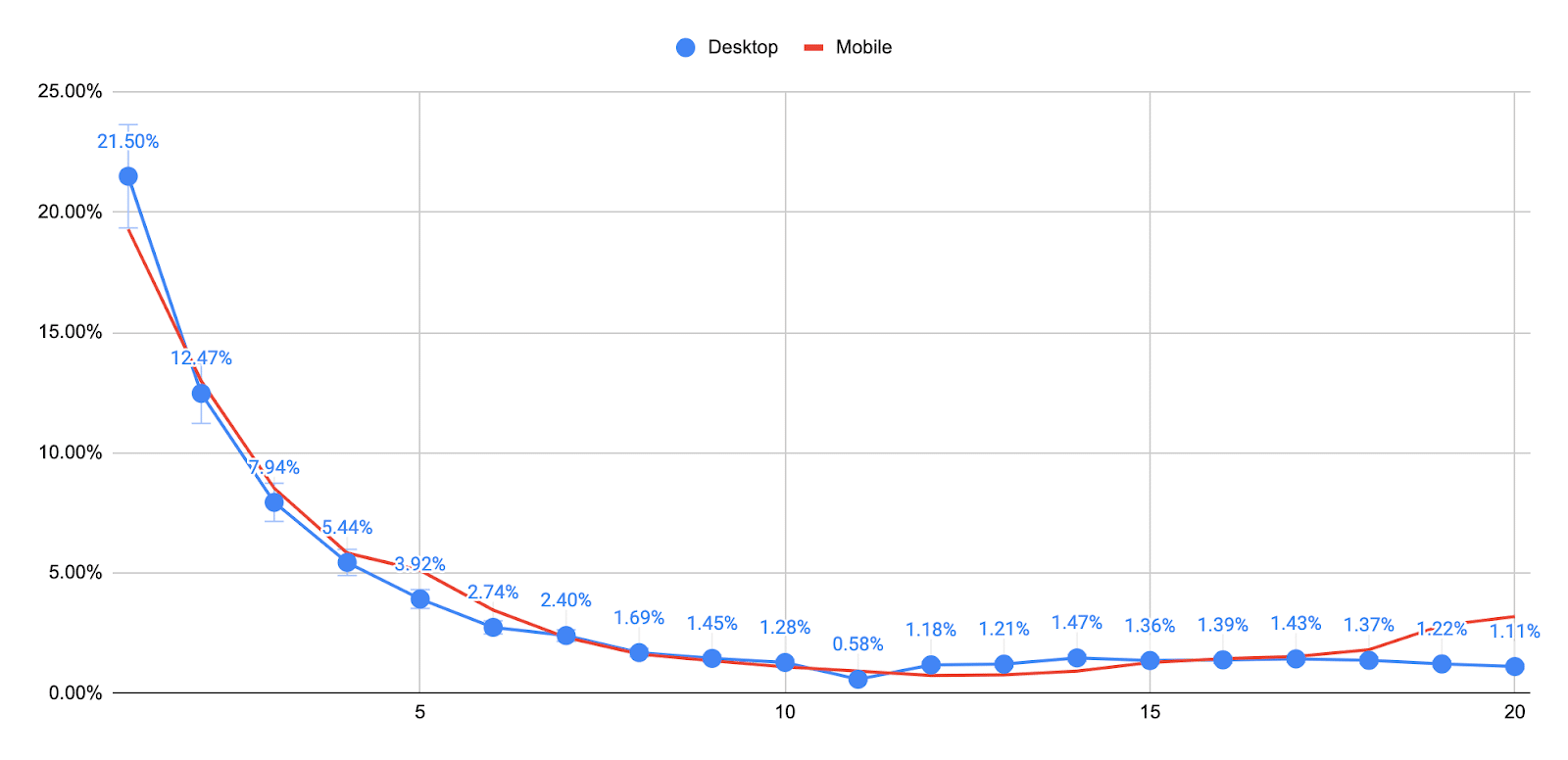 .
.
And in table form:
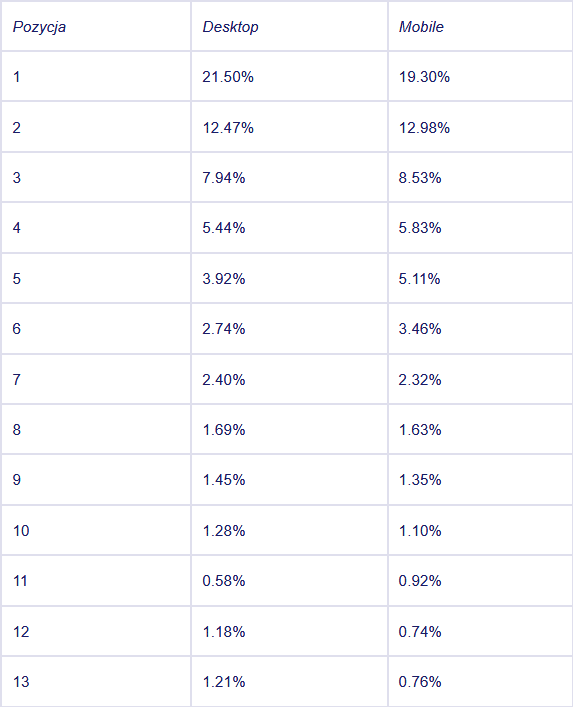
It is clear that the first positions in Google search results are by far the most clicked on. The farther away, the lower the number of clicks – results from the bottom of the page (10th position) have a CTR of just over 1%.
You want to sell a course on motivation in organizations through your site. The query “how to motivate an employee” is searched an average of 720 times per month – screen from Keyword Database:
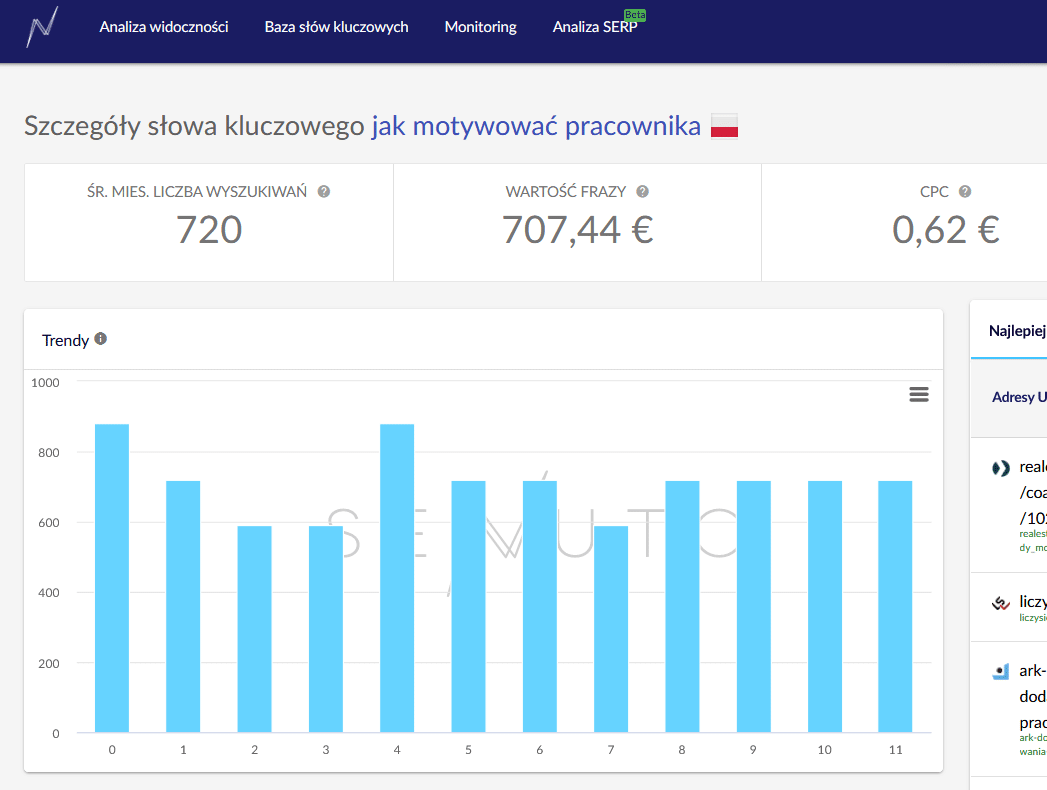 .
.
How many of the people who type this phrase into Google will come to your site depends on the position you occupy in Google (estimates based on inputs from desktop devices):
1 position: 720 x 21.5% = 155 visits per month, 1860 per year.
2nd Position: 720 x 12.47% = 90 visits per month, 1080 per year.
3rd position: 720 x 7.94% = 57 visits per month, 684 per year.
And so on.
Keep in mind that if you rank high for the phrase “how to motivate an employee“, you will also be visible on related phrases, such as “motivating employees” (averaging 1,300 searches per month) or “motivating employees”(720). Traffic will accumulate. Getting in between competitors may not be easy, but it is possible – and then, in the long run, you can count on very satisfying organic traffic to your site.
The answer to the question of how much you’ll earn from it depends on a variety of factors within your control, including the quality of your site’s performance or competitiveness and how you structure your bid. If 10,000 people enter from Google in a year, and 3% of them buy, you will sell 300 courses. If you earn 100 zlotys on one, then you can say that thanks to high positions in Google you have made an annual turnover of 30 thousand zlotys. And it doesn’t stop there – after all, the next year people will also be typing in Google queries about motivating employees.
Compare projected SEO costs with projected profits, and you’ll have an answer as to whether the campaign is paying off.
.
What else to consider when planning and monitoring an SEO campaign
.
The above examples were meant to give you an idea of how you can operate on the data to make your plans clearer and more specific. This is not a complete guide on how to design SEO efforts. Such a description would need a separate e-book. But here we can mention a few more factors to consider when thinking about your site’s performance on Google.
Visibility analysis, or how you are seen in Google
.
Not only you, but also your competitors. “To know where you’re going, you must know where you’re coming from,” says a naval proverb. Or is it from Lord of the Rings? Either way, knowing the current positions of your keywords and your competition will give you a better idea of the current situation and plan actions based on that.
With the Visibility Analysis module in Senuto, you can check the visibility in Google of any domain (there are several million of them in the database), and easily make comparisons:
- Common keywords – words for which both your domain and your competitors’ domains are visible,
- Competitor keywords – words on which your competitors are visible and your domain is not,
- My keywords – words for which your domain is visible, and your competitors’ domains are not.
.
.
.
For example, common keywords for the domains lidl.pl and carrefour.pl:
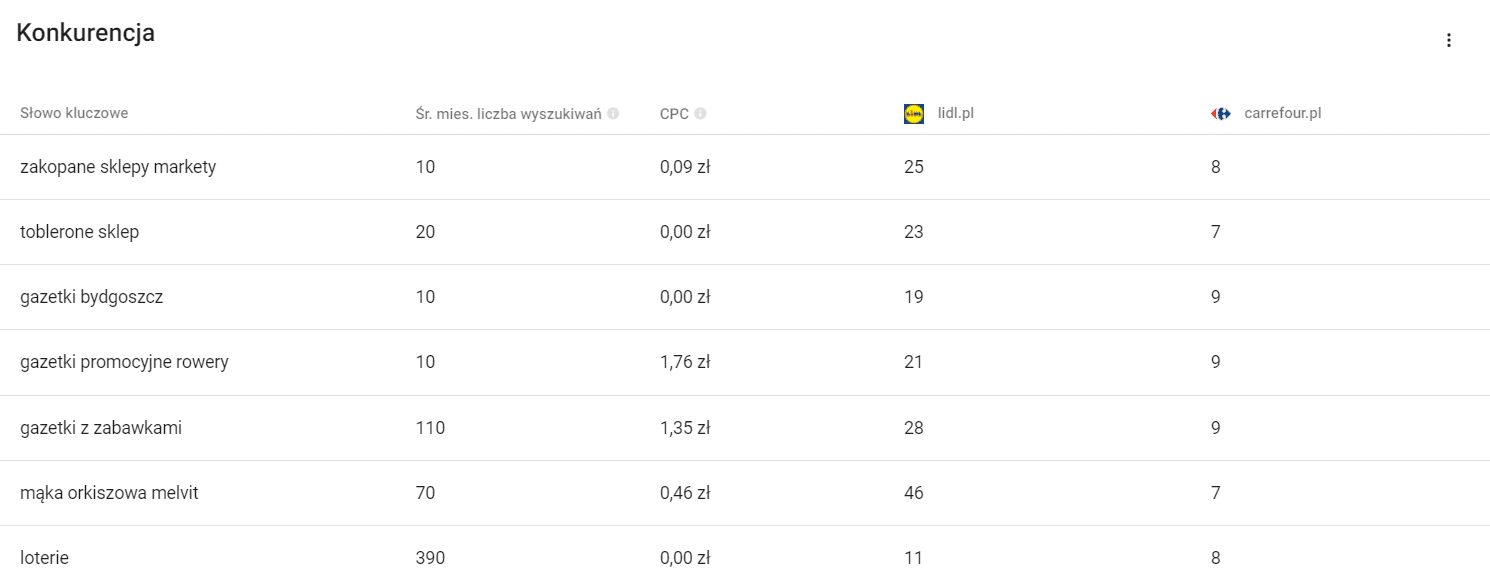
Of course, such data will change over time – sometimes you’re going up, sometimes you’re going down, and the same goes for your competition. It’s a good idea to check the positions of yourself and competing domains once in a while.
Quick wins
.
There is another interesting trick you can use when planning your SEO campaign. These are the so-called “quick wins“, or quick wins. The idea is to check the phrases for which your domain shows up in positions 11-20, that is, on the second page of Google search results.
These are phrases from which you probably don’t draw traffic to your site or draw trace amounts of traffic – hardly anyone looks at the second page of search results. At the same time,if you work on them a little, their position will grow and they will jump to the first page, providing you with additional traffic. It’s worth including these phrases in your SEO strategy. At a low cost, you can gain a lot.
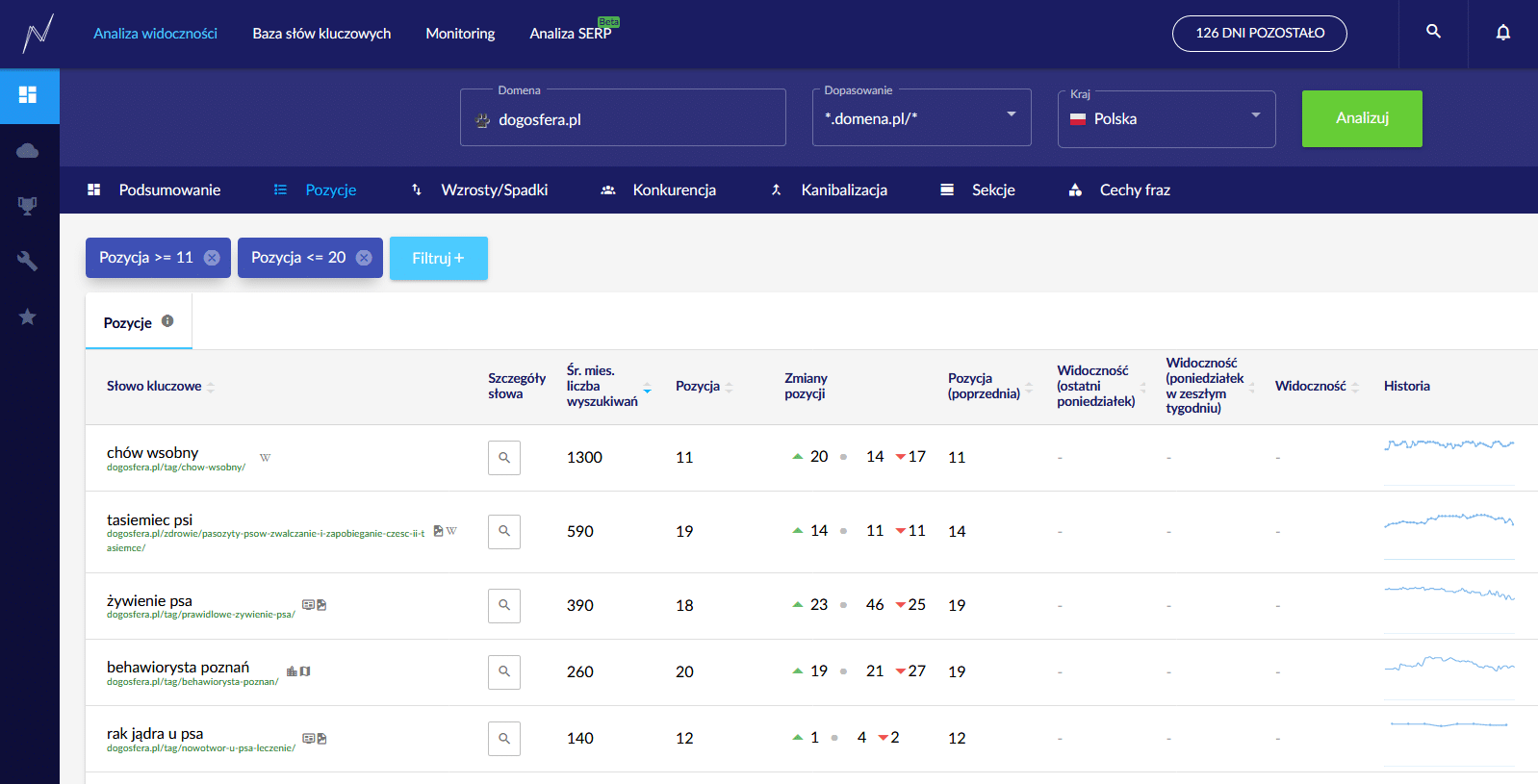
An example of “quick wins” domain dogosfera.pl. In the 11th position, i.e. just off the first page of search results, is a key phrase (inbreeding) with an average monthly number of searches of 1300! So it’s worth focusing on it in your SEO campaign and monitoring progress on an ongoing basis.
Monitoring progress
.
To know if your SEO efforts are having an effect, you need to observe changes over time. For how many keywords is my site visible in TOP3 today? And how many in TOP10 and TOP50? These questions, unfortunately, won’t be answered by the free Google Analytics – although it’s definitely worth using that tool, too, to study traffic sources and get to know your visitors from the demographics side – but again, we can turn to Senuto.
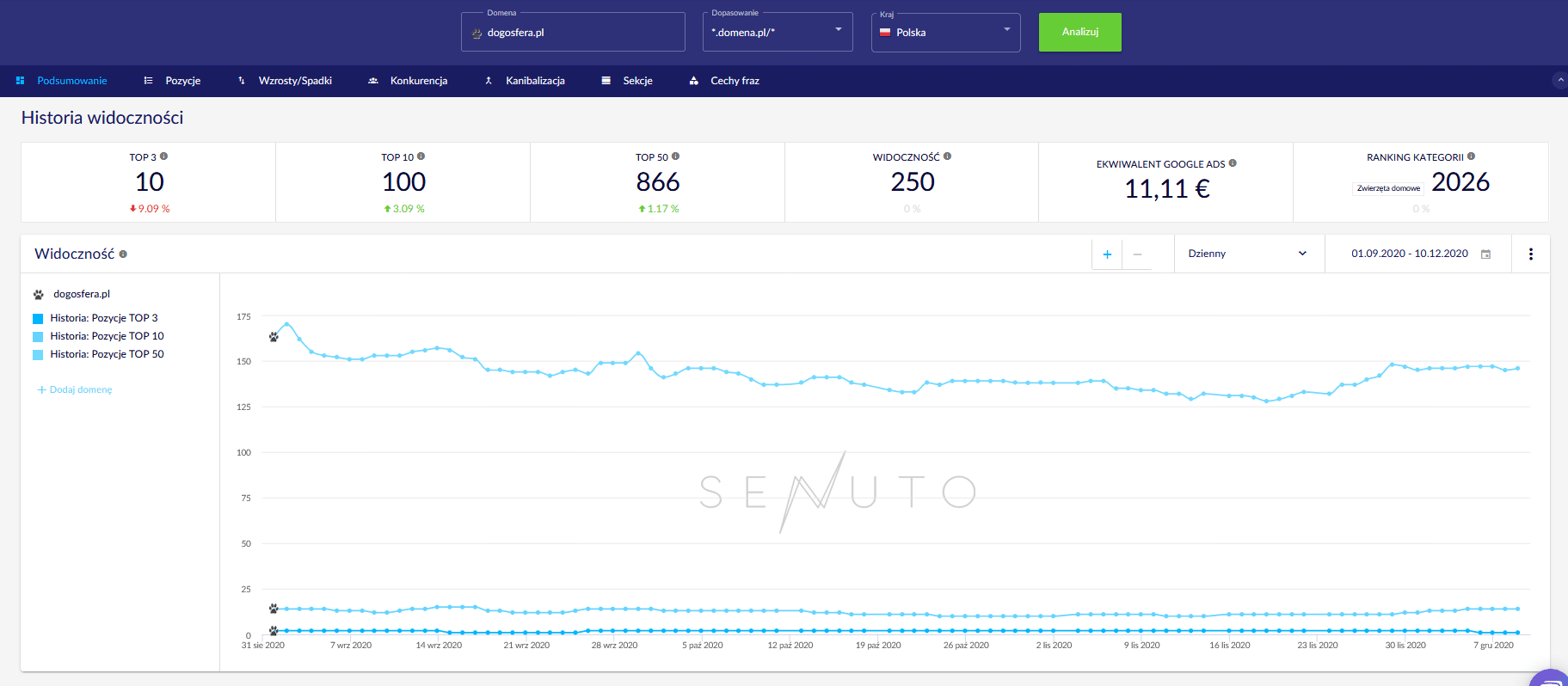
Quarterly changes in the visibility of the domain dogosfera.pl, including positions in TOP3, TOP10 and TOP50. There is also a table taking into account key phrases:
It is also possible – and advisable – to monitor specific phrases, for example “quick wins”, about which there was a bit above. To do this, you set up a project in the Monitoring module, where you specify domain and the phrases you are interested in, and get real-time reports on changes.
Summary
.
Working on SEO is working with data. So, when approaching the topic of using data to plan and monitor SEO campaigns, we have to agree to some simplifications and omissions – otherwise a book would come out of it. Let what has been written in this article serve as an inspiration to look at SEO on Google in a broader way. And, of course, start looking for data on your own that can be turned into results. There are plenty of them. Now you have a better idea of where to look, what to look for and for what purpose.
Thanks for reading!
Sign up for free and join over 14,000 Senuto users ????

 Wojciech Maroszek
Wojciech Maroszek